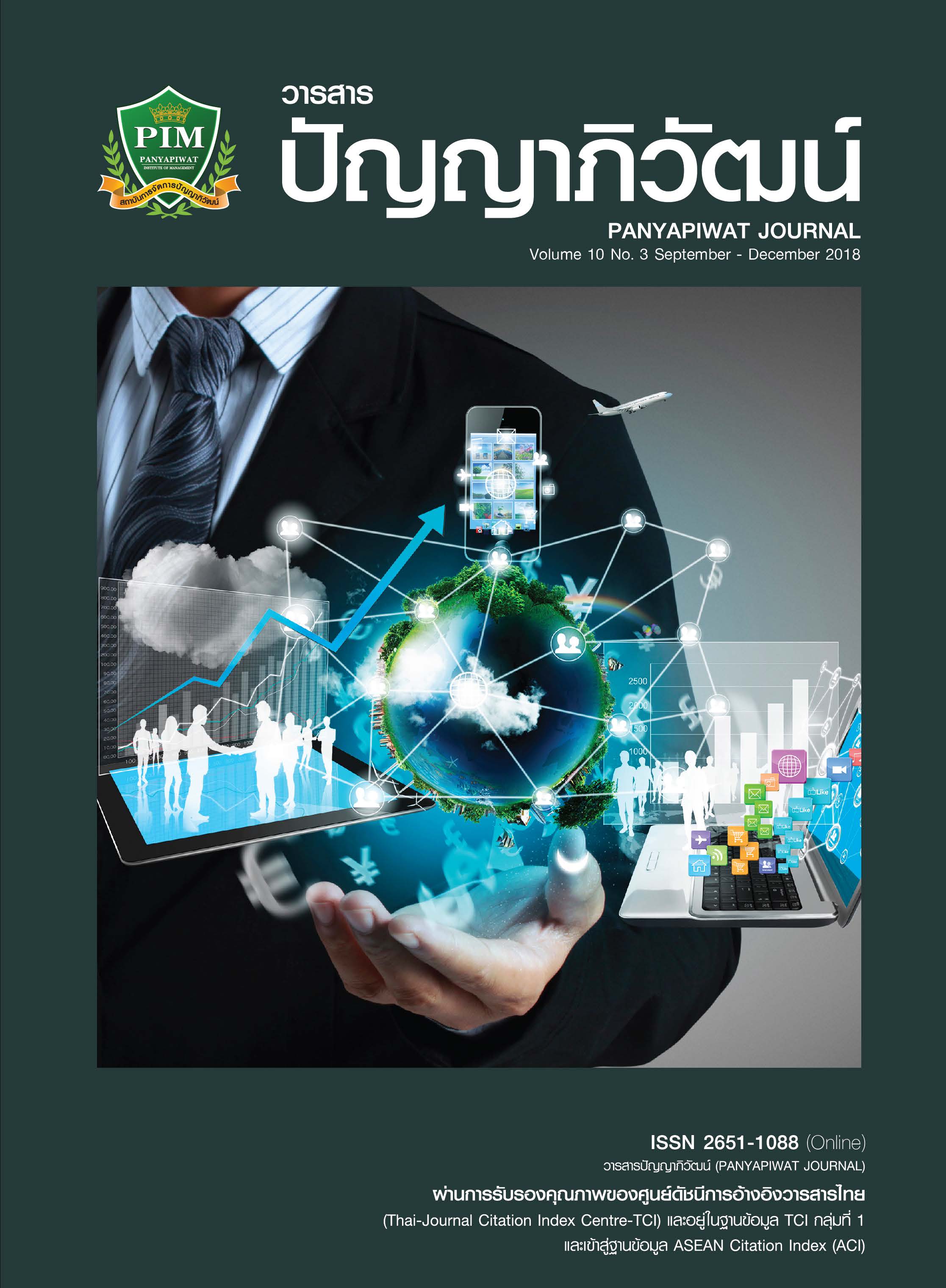MANAGEMENT NETWORK MODEL FOR CORPORATE SOCIAL RESPONSIBILITY OF JAPANESE COMPANIES BASES IN THAILAND
Main Article Content
Abstract
The research was a participatory action research (PAR). The purposes of this study were: 1. To analyze the community industrial area consist of four parts: 1) Circumstances before change 2) Participation between networks 3) The process makes a difference 4) The knowledge into sustainable change and 2. The network model of social responsibility of the Japanese company having production bases in Thailand. The sample was divided into three groups; The community located around the Amata Nakorn industrial estate with the radial distances not more than 50 kilometers, A Co., Ltd., B Co., Ltd., and undergraduate of Business Administration Management student. The content analysis was used for data analysis. The findings,from the participant observation and note analyzing the community industrial area, indicated that there are 19 issues that can be studied divided into fivesections as follows: 1) CSR on Natural Environment consisting of 5 issues 2) CSR on Economic 5 issues 3) CSR on Health and welfare 3 issues 4) CSR on Social 5 issues 5) CSR on Legal 1 issues. The results of the social sustainability network model of the Japanese company having production bases in Thailand can be divided into three parties; the company, the community, and the academy which are each divided into 3 levels: individual network, community/organization network and social network.
Article Details
I and co-author(s) certify that articles of this proposal had not yet been published and is not in the process of publication in journals or other published sources. I and co-author accept the rules of the manuscript consideration. Both agree that the editors have the right to consider and make recommendations to the appropriate source. With this rights offering articles that have been published to Panyapiwat Institute of Management. If there is a claim of copyright infringement on the part of the text or graphics that appear in the article. I and co-author(s) agree on sole responsibility.
References
Andrews, N. (2016). Challenges of corporate social responsibility (CSR) in domestic settings: An exploration of mining regulation vis-à-vis CSR in Ghana. Resources Policy, 47, 9-17.
Breeze, J. D. (1995). Henri Fayol’s Centre for Administrative Studies. Journal of Management History, 1(3), 37-62.
Chaiyasorn, W. & Kessapradit, B. (2017). Corporate Social Responsibility with Sustainable Development: Case studies of Corporate Social Responsibility in 6 companies. Journal of Psychiatry, 9(3), 140-152. [in Thai]
Corporate Social Responsibility Network. (2008). Knowing CSR. Retrieved December 24, 2016, from https://thaicsr.blogspot.com/2006/03/blog-post_20.html [in Thai]
Development Group Offce of the Public Sector Development Commission. (2009). Corporate Social Responsibility. Bangkok: Gen. Printing (1996). [in Thai]
Ding, D. K., Ferreira, C. & Wongchoti, U. (2016). Does it pay to be different? Relative CSR and its impact on frm value. International Review of Financial Analysis, 47, 86-98.
Djaballah, M., Hautbois, C. & Desbordes, M. (2016). Sponsors’ CSR strategies in sport: A sensemaking approach of corporations established in France. Sport Management Review, 20(2), 211-225.
Gill, R. (2015). Why the PR strategy of storytelling improves employee engagement and adds value to CSR: An integrated literature review. Public Relations Review, 41(5), 662-674.
Jirathiennat, K. (2002). Roadmap to Good Citizen in Business Corporate Governance Practices in the Real World (3rd ed.). Bangkok: Exponent. [in Thai]
Kim, J., Song, H., Lee, C. & Lee, J. Y. (2017). The impact of four CSR dimensions on a gaming company’s image and customers’ revisit intentions. International Journal of Hospitality Management, 61, 73-81.
Li, Y., Fu, H. & Huang, S. (2015). Does conspicuous decoration style influence customer’s intention to purchase? The moderating effect of CSR practices. International Journal of Hospitality Management, 51, 19-29.
Mithani, M. A. (2016). Innovation and CSR–Do They Go Well Together? Long Range Planning, 50(6), 699-711.
Nonthanatorn, P. (2010). Corporate social responsibility management: the creating competitive advantages sustainable competition. Nonthaburi: Thinking Beyond Books. [in Thai]
Offce of Industrial Product Standards Ministry of industry. (2009). Standard of Social Responsibility – ISO26000. Retrieved December 24, 2016, from https://www.tisi.go.th/training52/26000_52/presentation.html [in Thai]
Palihawadana, D., Oghazi, P. & Liu, Y. (2016). Effects of ethical ideologies and perceptions of CSR on consumer behavior. Journal of Business Research, 69(11), 4964-4969.
Prahalad, C. K. & Hammond, A. (1998). Harvard Business Review on Corporate Responsibility. (N. Sintarakanphon, Trans.). Bangkok: Artist Print. [in Thai]
Srivijaya, K. & Ketmaris, N. (2002). Business Networking. Bangkok: Thirak Phorn Vannakam. [in Thai]
Venturelli, A., Caputo, F., Leopizzi, R., Mastroleo, G. & Mio, C. (2017). How can CSR identity be evaluated? A pilot study using a Fuzzy Expert System. Journal of Cleaner Production, 141, 1000-1010.
Wanvik, T. I. (2016). Governance transformed into Corporate Social Responsibility (CSR): New governance innovations in the Canadian oil sands. The Extractive Industries and Society, 3(2), 517-526.
Wittayawutthikul, R. (2014). Development of Social Networking Model for Productivity. A research of Thai Research University. Graduate Diploma Program in Information Science, Sukhothai Thammathirat Open University. [in Thai]
Zinn, M. (2013). The future of management. Retrieved December 24, 2016, from https://www.slideshare.net/marianzinn/gary-hamel-2007-the-future-of-management-marian-zinn


